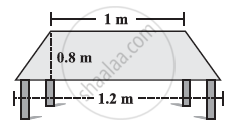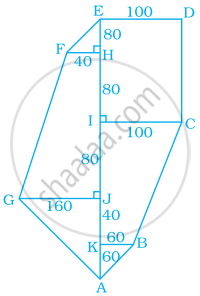Advertisements
Advertisements
प्रश्न
Find the missing values.
| Height 'h' | Parallel side 'a` | Parallel side 'b` | Area |
| 16 cm | 15 cm | 360 sq.cm |
उत्तर
Given: The height h = 16 cm
Parallel sides a = 15 cm
Area of the trapezium = 360 sq.cm
`1/2` × h × (a + b) = 360
`1/2` × 16 × (15 + b) = 360
15 + b = `360/8`
15 + b = 45
b = 45 – 15 = 30
b = 30 cm
Tabulating the results we get
| Height 'h' | Parallel side 'a` | Parallel side 'b` | Area |
| 16 cm | 15 cm | 30 cm | 360 sq.cm |
APPEARS IN
संबंधित प्रश्न
The shape of the top surface of a table is a trapezium. Find its area if its parallel sides are 1 m and 1.2 m and perpendicular distance between them is 0.8 m.

Find the area, in square metres, of the trapezium whose bases and altitude is as under:
bases = 150 cm and 30 dm, altitude = 9 dm.
Find the height of a trapezium, the sum of the lengths of whose bases (parallel sides) is 60 cm and whose area is 600 cm2.
Find the altitude of a trapezium whose area is 65 cm2 and whose bases are 13 cm and 26 cm.
If the area of a trapezium is 28 cm2 and one of its parallel sides is 6 cm, find the other parallel side if its altitude is 4 cm.
The two parallel sides and the distance between them are in the ratio 3: 4: 2. If the area of the trapezium is 175 cm2, find its height.
The area of a trapezium is 1586 sq.cm. The distance between its parallel sides is 26 cm. If one of the parallel sides is 84 cm then find the other side
The area of the trapezium, if the parallel sides are measuring 8 cm and 10 cm and the height 5 cm is
The areas of two circles are in the ratio 49 : 64. Find the ratio of their circumferences.
Find the area of the following fields. All dimensions are in metres.

